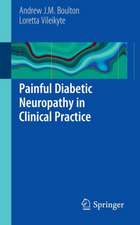Pancreatic Beta Cell in Health and Disease
Editat de Susumu Seino, Graeme I. Bellen Limba Engleză Paperback – 20 oct 2010
| Toate formatele și edițiile | Preț | Express |
|---|---|---|
| Paperback (1) | 1117.03 lei 6-8 săpt. | |
| Springer – 20 oct 2010 | 1117.03 lei 6-8 săpt. | |
| Hardback (1) | 1124.15 lei 6-8 săpt. | |
| Springer – 17 dec 2007 | 1124.15 lei 6-8 săpt. |
Preț: 1117.03 lei
Preț vechi: 1362.23 lei
-18% Nou
Puncte Express: 1676
Preț estimativ în valută:
213.74€ • 222.63$ • 178.18£
213.74€ • 222.63$ • 178.18£
Carte tipărită la comandă
Livrare economică 28 martie-11 aprilie
Preluare comenzi: 021 569.72.76
Specificații
ISBN-13: 9784431998372
ISBN-10: 4431998373
Pagini: 492
Ilustrații: XV, 476 p.
Dimensiuni: 155 x 235 x 26 mm
Greutate: 0.68 kg
Ediția:Softcover reprint of hardcover 1st ed. 2008
Editura: Springer
Colecția Springer
Locul publicării:Tokyo, Japan
ISBN-10: 4431998373
Pagini: 492
Ilustrații: XV, 476 p.
Dimensiuni: 155 x 235 x 26 mm
Greutate: 0.68 kg
Ediția:Softcover reprint of hardcover 1st ed. 2008
Editura: Springer
Colecția Springer
Locul publicării:Tokyo, Japan
Public țintă
ResearchDescriere
The beta cells of the pancreatic islets of Langerhans are the only cells in the body that produce and secrete insulin, a key metabolic hormone, which plays a central role in the maintenance of glucose homeostasis regulating glucose uptake in muscle and adipose tissue as well as carbohydrate, fat, and protein metabolism in these tissues and the liver. Failure of normal beta-cell function can lead to hyperglycemia (diabetes mellitus) or hypoglycemia. While hy- glycemia is a rare and life-threatening condition in which the beta cell secretes too much insulin, diabetes mellitus is a common disorder that is fast bec- ing an epidemic. It is a major threat to human health in the 21st century. The number of diabetic patients worldwide is rapidly increasing and is predicted to reach 380 million by 2025, according to the International Diabetes Fede- tion (IDF). Diabetes mellitus is a heterogeneous disorder with some forms such as maturity-onset diabetes of the young and permanent neonatal diabetes being primary genetic disorders of the beta cell. Monogenic forms of diabetes are an uncommon cause of diabetes representing about 1% of cases. The common forms of diabetes mellitus, designated type 1 and type 2, are multifactorial in origin with both genetic and environmental factors contributing to their development. Type 1 diabetes is caused by autoimmune destruction of beta cells leading to an absolute de? ciency of insulin and fatal hyperglycemia and ketoacidosis if not treated.
Cuprins
Pancreatic Beta Cell and Insulin Biosynthesis.- Architecture of Pancreatic Islets.- Transcriptional Regulation of Insulin Gene Expression.- The Biosynthesis of Insulin.- Cell Signaling and Insulin Secretion.- Metabolic Regulation of Insulin Secretion.- Mechanisms of Beta-Cell Death in Diabetes.- Ion Channels and Insulin Secretion.- Gap Junctions and Insulin Secretion.- Protein Kinase A-Independent Mechanism of cAMP in Insulin Secretion.- Regulation of Insulin Granule Exocytosis.- Mechanism of Insulin Exocytosis Analyzed by Imaging Techniques.- Two-Photon Excitation Imaging of Insulin Exocytosis.- Pancreatic Development and Beta-Cell Formation.- Regulation of Beta-Cell Growth and Death.- Beta-Cell Replication.- Stem Cells as a Cure for Diabetes.- Use of Extra-Pancreatic Tissues for Cell Replacement Therapy for Diabetes.- Incretins and Beta-Cell Function.- Molecular Biology of Gluco-Incretin Function.- Incretins and Regulation of Insulin Secretion.- Pancreatic Beta Cell and Disease.- Pancreatic Islet Pathology in Type 2 Diabetes.- Genetic Disorders of the Pancreatic Beta Cell and Diabetes (Permanent Neonatal Diabetes and Maturity-Onset Diabetes of the Young).- ATP-Sensitive Potassium Channels in Health and Disease.- Glucokinase in Glucose Homeostasis, Diabetes Mellitus, Hypoglycemia, and as Drug Receptor.
Caracteristici
Comprehensive up-to-date review of the beta cell in health and disease
Aims to encourage students and young basic and clinical investigators to become actively involved in diabetes research and the search for new approaches to prevent and treat diabetes
Aims to encourage students and young basic and clinical investigators to become actively involved in diabetes research and the search for new approaches to prevent and treat diabetes










